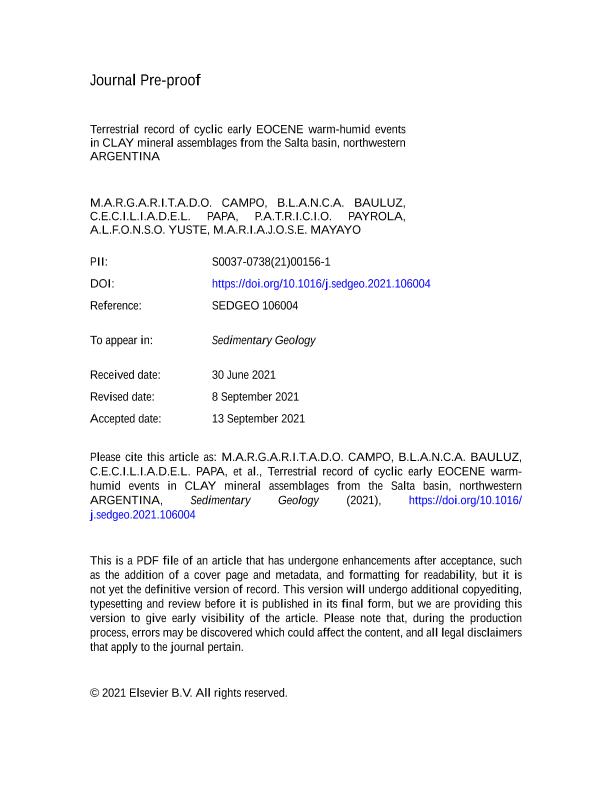Artículo
Terrestrial record of cyclic early Eocene warm-humid events in clay mineral assemblages from the Salta basin, northwestern Argentina
Do Campo, Margarita Diana ; Bauluz, Blanca; del Papa, Cecilia Eugenia
; Bauluz, Blanca; del Papa, Cecilia Eugenia ; Payrola Bosio, Patricio Augusto
; Payrola Bosio, Patricio Augusto ; Yuste, Alfonso; Mayayo, Maria Jose
; Yuste, Alfonso; Mayayo, Maria Jose
 ; Bauluz, Blanca; del Papa, Cecilia Eugenia
; Bauluz, Blanca; del Papa, Cecilia Eugenia ; Payrola Bosio, Patricio Augusto
; Payrola Bosio, Patricio Augusto ; Yuste, Alfonso; Mayayo, Maria Jose
; Yuste, Alfonso; Mayayo, Maria Jose
Fecha de publicación:
11/2021
Editorial:
Elsevier Science
Revista:
Sedimentary Geology
ISSN:
0037-0738
Idioma:
Inglés
Tipo de recurso:
Artículo publicado
Clasificación temática:
Resumen
The Eocene continental sequence investigated in this study belongs to the Salta Group; it was deposited in an intracontinental rift, the Salta Basin (NW Argentina) that evolved from the Lower Cretaceous to middle Paleogene. The Salta Group contains the Maíz Gordo and Lumbrera Fms, spans the Paleocene-early Eocene, and shows excellent exposures in the region of the Valles Calchaquíes. This research is focused on the continental facies of the Lumbrera Fm, which correspond to the early Eocene. We studied the mineralogy of the fine-grained beds of the Lumbrera Fm in five locations (Valle Encantado, Tonco, Tin Tin, Luracatao, and Obelisco) by X-ray diffraction and scanning electron microscopy in order to examine the vertical variations in clay mineralogy and their relations with global paleoclimatic changes registered during the Eocene. The microtexture of the authigenic smectite-type clays (Sm to I/Sm R0) suggests that they mainly originated by crystallization from glassy volcanic materials. The high reactivity of the glass precludes the use of smectite-type-clay formation as an indicator of specific paleoclimatic conditions in the studied sediments. In contrast, the formation of kaolinite in sections with very low smectite proportions and a strong degree of weathering in crystalline silicates reflects intense weathering conditions and is a useful paleoclimatic proxy in terrestrial sediments. Significant variations in kaolinite/muscovite ratios at the base and in an intermediate bed in the Lumbrera Fm at Valle Encantado suggest the presence of cyclic hyperthermals through the Ypresian stage that may be tentatively correlated with the Eocene Thermal Maxima 2 and 3, which are the largest events that have been identified at a global scale in early Eocene marine sediments.
Palabras clave:
EARLY EOCENE PALEOCLIMATE
,
KAOLINITE
,
SALTA BASIN
,
SMECTITE COMPOSITION
Archivos asociados
Licencia
Identificadores
Colecciones
Articulos(CICTERRA)
Articulos de CENTRO DE INVEST.EN CS.DE LA TIERRA
Articulos de CENTRO DE INVEST.EN CS.DE LA TIERRA
Articulos(IBIGEO)
Articulos de INST.DE BIO Y GEOCIENCIAS DEL NOA
Articulos de INST.DE BIO Y GEOCIENCIAS DEL NOA
Articulos(INGEIS)
Articulos de INST.DE GEOCRONOLOGIA Y GEOLOGIA ISOTOPICA (I)
Articulos de INST.DE GEOCRONOLOGIA Y GEOLOGIA ISOTOPICA (I)
Citación
Do Campo, Margarita Diana; Bauluz, Blanca; del Papa, Cecilia Eugenia; Payrola Bosio, Patricio Augusto; Yuste, Alfonso; et al.; Terrestrial record of cyclic early Eocene warm-humid events in clay mineral assemblages from the Salta basin, northwestern Argentina; Elsevier Science; Sedimentary Geology; 425; 106004; 11-2021; 1-56
Compartir
Altmétricas



